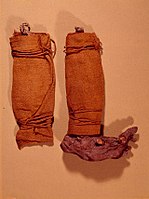Puttee

Aputtee(also spelledputtie,adapted from theHindipaṭṭī,meaning "bandage" ) is a covering for the lower part of the leg from the ankle to the knee, also known as:legwraps,leg bindings,winingasandWickelbänderetc. They consist of a long narrow piece of cloth wound tightly, and spirally round the leg, and serving to provide both support (as acompression garment) and protection. They were worn by both mounted and dismounted soldiers, generally taking the place of theleatherorclothgaiter.
History[edit]
Worn since antiquity, the puttee was adopted as part of the service uniform of foot and mounted soldiers serving inBritish Indiaduring the second half of the nineteenth century. In its original form the puttee comprised long strips of cloth worn as a tribal legging in the Himalayas. TheBritish Indian Armyfound this garment to be both comfortable and inexpensive, although it was considered to lack the smartness of thegaiterpreviously worn.[1]According to the British author and soldierPatrick Leigh Fermor,infantry puttees were wound up from ankle to knee, but in cavalry regiments they were wound down from knee to ankle.[2]
The puttee was subsequently widely adopted by a number of armies including those of theBritish Commonwealth,theAustro-Hungarian Army,the ChineseNational Revolutionary Army,theBelgian Army,theEthiopian Army,theDutch Army,theImperial German Army(when stocks of leather long marching boots ran short duringWWI),[3]theFrench Army,theImperial Japanese Army,theItalian Army,thePortuguese Army,theOttoman Armyand theUnited States Army.Most of these armies adopted puttees during or shortly before World War I. Puttees were in general use by theBritish Armyas part of thekhakiservice uniformworn from 1902, until 1938 when a newbattledresswas introduced, which included shortwebbinggaiterssecured with buckles.[4]One of the largest providers of the puttee during World War I to the British Army was Fox Brothers, produced at Tonedale Mill, Somerset.[5]
Puttees generally ceased to be worn as part of military uniform during World War II. Reasons included the difficulty of quickly donning an item of dress that had to be wound carefully around each leg, plus medical reservations regarding hygiene andvaricose veins.[4]However the cheapness and easy availability of cloth leggings meant that they were retained in the Italian, French, Japanese and some other armies until various dates between 1941 and 1945. TheRed Armytypically used them with laced ankle boots where the legs were insufficiently protected, thoughjackbootswere more common.[6]
When the British Army finally replaced battledress with the1960 Pattern Combat Dress,[7]ankle high puttees replaced the webbing gaiters.[8]These continued to be worn until the 1980s.
-
Roman fasciae crurales, depicted in a 4th-century CE hunting scene
-
Puttees of bog boy Søgårds Mose Man, Denmark, early Iron Age
-
King Edgar of England, 966 CE
-
Battle of Hastings, 1066 CE
-
Soldiers of theQueen's Own Corps of Guidesof theBritish Indian Armyin 1897.[9]They are in various orders of uniform but all wear puttees.
In 2013, the remains of two teenaged Austrian First World War soldiers were found on thePresena glacier.One of them carried a spoon tucked into his puttees.[10]
Legacy[edit]

Two currentCanadian infantry regimentswere given nicknames based on non-standard leg wear: theRoyal Newfoundland Regimentand the48th Highlanders of Canada.
At the outbreak ofWorld War ItheDominion of Newfoundlandraised aregimentfor active service. Lacking a localmilitiaorgarrisonof soldiers, there were no military stores; uniforms had to be fashioned from scratch. In the absence of khaki broadcloth, puttees were fashioned from blue broadcloth. The Newfoundland Regiment was thus nicknamed "The Blue Puttees". This distinctive feature was retained for several months until the regiment was issued with standard British Army uniform and equipment upon arrival in England.[11]
DuringWorld War II,1 Brigade of the1st Canadian Divisionwas being inspected by KingGeorge VI.By this date the traditional knee-length puttees had been replaced with short ankle-length leggings worn with battledress. There were not enough khaki leggings for issue, so the 48th Highlanders made do with unofficial blue ones reportedly cut down from stocks of blue cloth found in regimental stores. The King inquired as to why the 48th wore different "puttees" from the rest of the brigade. Upon being told of the shortage, the king replied that he liked the blue puttees better and that they should keep them. The 48th Highlanders continued to wear blue puttees until the regimental service dress was eventually phased out.[citation needed]
See also[edit]
- Footwraps– Cloth wrapped around the feet instead of socks
- Gaiters– Garment worn over the shoe and lower pants leg
- Leggings– Several types of leg coverings
Notes[edit]
- This article incorporates text from a publication now in thepublic domain:Chisholm, Hugh,ed. (1911). "Puttee".Encyclopædia Britannica(11th ed.). Cambridge University Press.
References[edit]
- ^Boris Mollo, p158 "The Indian Army",ISBN0 7137 1074 8
- ^Quoted in "Patrick Leigh Fermor: An Adventure" by Artemis Cooper, London 2012, page 37
- ^Ball, Stephen.World War One German Army.p. 85.ISBN1-85753-271-6.
- ^abR.M. Barnes, p282 "A History of the Regiments & Uniforms of the British Army", First Sphere Books 1972
- ^"BBC - World War One At Home, Tonedale Mill, Somerset: Weaving Puttees For Worldwide Soldiers".BBC.Retrieved2020-01-29.
- ^Soviet Reenactment - footwear
- ^Jewell, Brian.British Battledress1937-61.p. 10.ISBN850450-387-9.
- ^Smith, Digby (1977)The British Army 1965-80,Osprey Publishing,ISBN9780850452730(p. 12)
- ^Boris Mollo, p128 "The Indian Army",ISBN0 7137 1074 8
- ^Laura Spinney (13 January 2014)."Melting glaciers in northern Italy reveal corpses of WW1 soldiers".Daily Telegraph.Archived fromthe originalon 14 January 2014.
- ^Rene Chartrand.The Canadian Corps in World War I.p. 46.ISBN978 184603 186 1.





![Soldiers of the Queen's Own Corps of Guides of the British Indian Army in 1897.[9] They are in various orders of uniform but all wear puttees.](https://upload.wikimedia.org/wikipedia/commons/thumb/a/a4/Pre-1900_Indian_soldiers.jpg/200px-Pre-1900_Indian_soldiers.jpg)